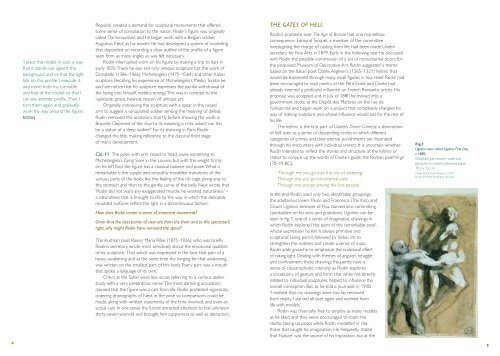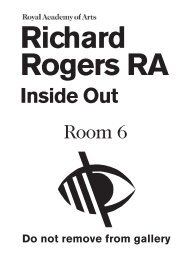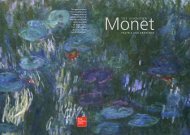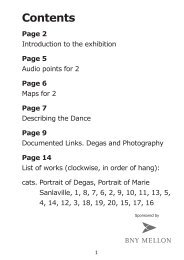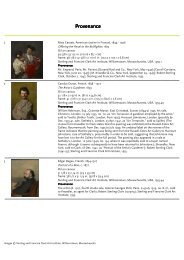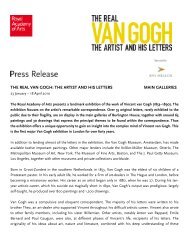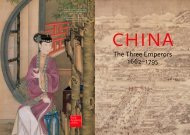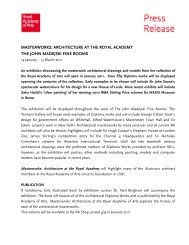rodin - Royal Academy of Arts
rodin - Royal Academy of Arts
rodin - Royal Academy of Arts
You also want an ePaper? Increase the reach of your titles
YUMPU automatically turns print PDFs into web optimized ePapers that Google loves.
4<br />
‘I place the model in such a way<br />
that it stands out against the<br />
background and so that the light<br />
falls on this pr<strong>of</strong>ile. I execute it,<br />
and move both my turntable<br />
and that <strong>of</strong> the model, so that I<br />
can see another pr<strong>of</strong>ile.Then I<br />
turn them again, and gradually<br />
work my way around the figure.’<br />
RODIN<br />
Republic created a demand for sculptural monuments that <strong>of</strong>fered<br />
some sense <strong>of</strong> consolation to the nation. Rodin’s figure was originally<br />
called The Vanquished, and he began work with a Belgian soldier,<br />
Augustus Neyt, as his model. He had developed a system <strong>of</strong> modelling<br />
that depended on recording a clear outline <strong>of</strong> the pr<strong>of</strong>ile <strong>of</strong> a figure<br />
seen from as many angles as was felt necessary.<br />
Rodin interrupted work on his figure by making a trip to Italy in<br />
early 1876.There he saw not only antique sculpture but the work <strong>of</strong><br />
Donatello (1386–1466), Michelangelo (1475–1564) and other Italian<br />
sculptors. Recalling his experience <strong>of</strong> Michelangelo’s Medici Tombs he<br />
said ‘we notice that his sculpture expresses the painful withdrawal <strong>of</strong><br />
the being into himself, restless energy.’This was in contrast to the<br />
‘quietude, grace, balance, reason’ <strong>of</strong> antique art.<br />
Originally conceiving the sculpture with a spear in the raised<br />
arm to suggest a vanquished soldier sensing the meaning <strong>of</strong> defeat,<br />
Rodin removed this accessory shortly before showing the work in<br />
Brussels. Deprived <strong>of</strong> this clue to its meaning, a critic asked:‘can this<br />
be a statue <strong>of</strong> a sleep walker?’ For its showing in Paris Rodin<br />
changed the title, making reference to the classical third stage<br />
<strong>of</strong> man’s development.<br />
Cat. 11 The pose, with arm raised to head, owes something to<br />
Michelangelo’s Dying Slave in the Louvre, but with the weight firmly<br />
on his left foot the figure has a classical balance and poise.What is<br />
remarkable is the supple and smoothly modelled transitions <strong>of</strong> the<br />
various parts <strong>of</strong> the body, like the feeling <strong>of</strong> the rib cage giving way to<br />
the stomach and then to the gentle curve <strong>of</strong> the belly. Neyt wrote that<br />
‘Rodin did not want any exaggerated muscle, he wanted naturalness’ –<br />
a naturalness that is brought to life by the way in which the delicately<br />
moulded surfaces reflect the light in a discontinuous fashion.<br />
How does Rodin create a sense <strong>of</strong> imminent movement?<br />
Given that the best points <strong>of</strong> view are from the front and to the spectator’s<br />
right, why might Rodin have removed the spear?<br />
The Austrian poet Rainer Maria Rilke (1875–1926), who was briefly<br />
Rodin’s secretary, wrote most sensitively about the emotional qualities<br />
<strong>of</strong> his sculpture.‘That which was expressed in the face, that pain <strong>of</strong> a<br />
heavy awakening and at the same time the longing for that awakening,<br />
was written on the smallest part <strong>of</strong> this body. Every part was a mouth<br />
that spoke a language <strong>of</strong> its own.’<br />
Critics at the Salon were less acute, referring to ‘a curious atelier<br />
study with a very pretentious name.’The most damning accusation<br />
claimed that the figure was a cast from life. Rodin protested vigorously,<br />
ordering photographs <strong>of</strong> Neyt in the pose so comparisons could be<br />
made, along with written statements <strong>of</strong> the time involved, and even an<br />
actual cast. In one sense the furore attracted attention to the unknown<br />
thirty-seven-year-old and brought him supporters as well as detractors.<br />
THE GATES OF HELL<br />
Rodin’s problems over The Age <strong>of</strong> Bronze had one marvellous<br />
consequence. Edmund Turquet, a member <strong>of</strong> the committee<br />
investigating the charge <strong>of</strong> casting from life, had been made Undersecretary<br />
for Fine <strong>Arts</strong> in 1879. Early in the following year he discussed<br />
with Rodin the possible commission <strong>of</strong> a set <strong>of</strong> monumental doors for<br />
the proposed Museum <strong>of</strong> Decorative Art. Rodin suggested a theme<br />
based on the Italian poet Dante Alighieri’s (1265–1321) Inferno that<br />
would be expressed through many small figures in low relief. Rodin had<br />
been encouraged to read poetry at the Petit Ecole and Dante had<br />
already exerted a pr<strong>of</strong>ound influence on French Romantic artists. His<br />
proposal was accepted and in July <strong>of</strong> 1880 he moved into a<br />
government studio at the Dépôt des Marbres on the rue de<br />
l’Université and began work on a project that completely changed his<br />
way <strong>of</strong> making sculpture and whose influence would last for the rest <strong>of</strong><br />
his life.<br />
The Inferno is the first part <strong>of</strong> Dante’s Divine Comedy, a description<br />
<strong>of</strong> hell seen as a series <strong>of</strong> descending circles in which different<br />
categories <strong>of</strong> crimes and their eternal punishments are illustrated<br />
through his encounters with individual sinners. It is uncertain whether<br />
Rodin intended to reflect the stories and structure <strong>of</strong> the Inferno or<br />
rather to conjure up the words <strong>of</strong> Dante’s guide, the Roman poet Virgil<br />
(70–19 BC):<br />
‘Through me you go into the city <strong>of</strong> weeping;<br />
Through me you go into eternal pain;<br />
Through me you go among the lost people.’<br />
In the end Rodin used only two identifiable groupings,<br />
the adulterous lovers Paolo and Francesca (The Kiss), and<br />
Count Ugolino, betrayer <strong>of</strong> Pisa, starved into committing<br />
cannibalism on his sons and grandsons. Ugolino can be<br />
seen in fig. 1, one <strong>of</strong> a series <strong>of</strong> imaginative drawings in<br />
which Rodin explored ‘the spirit <strong>of</strong> this remarkable poet’,<br />
whose expression he felt ‘is always primitive and<br />
sculptural.’ Using pencil, followed by Indian ink to<br />
strengthen the outlines and create a sense <strong>of</strong> mass,<br />
Rodin adds gouache to emphasise the sculptural effect<br />
<strong>of</strong> raking light. Dealing with themes <strong>of</strong> anguish, struggle<br />
and confinement, these drawings frequently have a<br />
sense <strong>of</strong> claustrophobic intensity as Rodin explores<br />
a vocabulary <strong>of</strong> gesture and form, that while not directly<br />
related to individual sculptures, helped to influence the<br />
overall conception. But, as he told a journalist in 1900:<br />
‘I realised that my drawings were too far removed<br />
from reality. I started all over again and worked from<br />
life with models.’<br />
Rodin was financially free to employ as many models<br />
as he liked, and they were encouraged to roam the<br />
studio, taking up poses while Rodin modelled in clay<br />
those that caught his imagination. He frequently stated<br />
that ‘Nature’ was the source <strong>of</strong> his inspiration, but at the<br />
Fig.1<br />
Ugolino, also called Ugolino First Day,<br />
c.1880<br />
Graphite, pen, brown wash and<br />
gouache on cream-coloured paper<br />
19.3 x 12 cm<br />
Musée Rodin, Paris/Meudon, D. 9393<br />
Photo © Musée Rodin/Jean de Calan<br />
5


